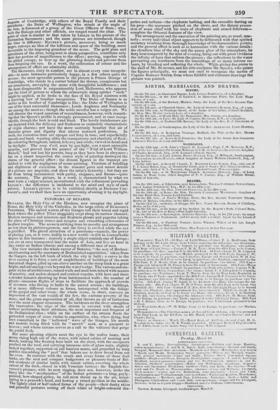PANORAMA OF BENARES.
BENARES, the Holy City of the Hindoos, now occupies the place of Rome, the Holy City of the Catholics, in the large circle of BIJRFORD's Panorama. The sacred waters of the Ganges roll their broad and rapid flood where the yellow Tiber sluggishly crept along its narrow channel; Moslem mosques and minarets and Brahmin ghauts and pagodas taking the place of Christian domes and steeples and crumbling colonnades of heathen temples. The scene is striking from its novelty and strangeness
no less than its picturesqueness, and. the fancy is excited while the eye is gratified. The grand attraction of a panorama-namely, the power of placing you, as it were, bodily in a new world-is felt in a remarkable degree in this instance : scarcely a single object reminds one of Europe ; you are at once transported into the midst of Asia, and live an hour in idea under an Indian climate and among a difffirent race of men.
The view includes the whole extent of Benares, "the seat of Brahmi- Meal learning and the sanctuary of Brahminical superstition," taken from the Ganges, on the left bank of which the city is built ; a curve in the river causing it to form a sort of amphitheatre of buildings of the most fantastical shapes, piled up one above another on the steep bank to a great height, and advancing even beyond the water's edge. The various and sin- gular styles of architecture, ruined walls and mud huts mixed with masses of masonry, and melon-shaped and conical cupolas, with here and there a slender minaret shooting up from battlemented walls ; the number of ghauts-immense flights of steps to facilitate the approach of crowds of devotees who throng to bathe in the sacred stream ; the buildings, of as many different colours as forms, interspersed with the foliage of the peepul and other trees : the whole scene, in short, conveys an hupression of the vast wealth of the few, the extreme poverty of the many, and the gross superstition of all, that throws an air of barbarism over the most elegant structures. The incidents on the river strengthen this impression : the edge of the stream is covered with shoals of bathers performing their ablutions, the most important and frequent of the Brahminical rites ; while on the surface of the stream floats the garlanded corpse of some victim to superstition, who, when dying, had been committed to the " hallowed." wave of the Ganges, his mouth and nostrils being filled with its " sacred" mud, as a passport to heaven ; and whose carcase serves as a raft to the vultures that gorge the putrid flesh.
But more pleasing objects meet the eye in the native boats, their sterns rising high out of the water, with raised cabins of matting and thatch, looking like floating buts built on the slant, with the occupants perched on the roof, and carrying immense sails of grass mats, slightly tacked together, supported on tall bamboo masts, and propelled by long paddles resembling the " peel" that bakers use to draw bread from out the oven. In contrast with the crank and crazy forms of these frail barks, are the neat and compact budgerows or pleasure-boats of l3ri- fish residents of similar build, with raised cabins, covering the whole extent of the deck, closed in with Venetian lattices : the English Go- vernor's pinnace, with its neat rigging, does not, however, strike the fancy like the " moahpunkee " of the Indian potentate-a long, gayly- painted, bow-shaped galley, its tall stern thrust up in the air, termi- nating in a peacock's head, and having a raised pavilion in the middle. The lightly-clad or half-naked forms of the people—their dusky skins and gracefill postures setting off their white or bright-coloured dra-
peries and turbans—the elephants bathing, and the crocodile darting on his prey—the marquees pitched on the shore, and the distant proces- sion of some chief with his train of elephants and armed followers— complete the Oriental features of the view.
The arrangement and the execution of the painting are, as usual, Mas- terly ; every individual object appears to be delineated with that spirited accuracy resulting from thorough knowledge of its characteristic points; and the general effect is such as to harmonize with the various details: the cloudless blue of the sky and the sunny glow of the atmosphere, its fiery heat tempered by the mist of evening, bring out with great vividness the infinity of hues that enliven the picture ; the reflections in the water preventing any harshness from the assemblage of so many intense co- lours, by blending and softening the whole. While giving due praise to the skill of Mr. B 'WORD, and. his able coadjutor Mr. SELOUS, who paints the figures principally, we must not omit to recognize the merits of Captain Bonnier SMITH, from whose faithful and elaborate drawings the picture was painted.


























 Previous page
Previous page